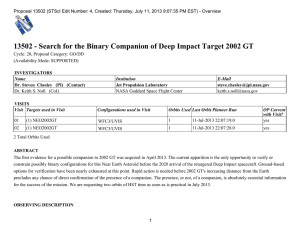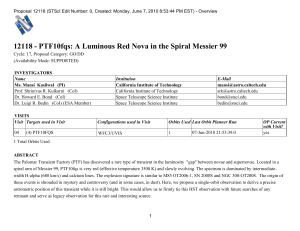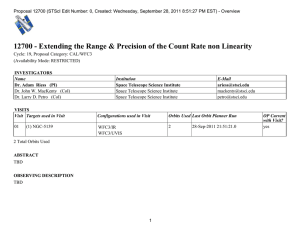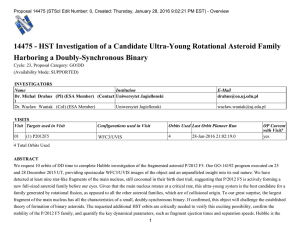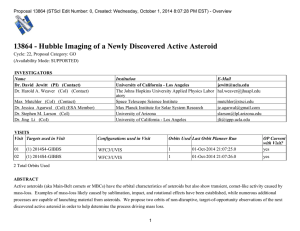Document 12643583
advertisement
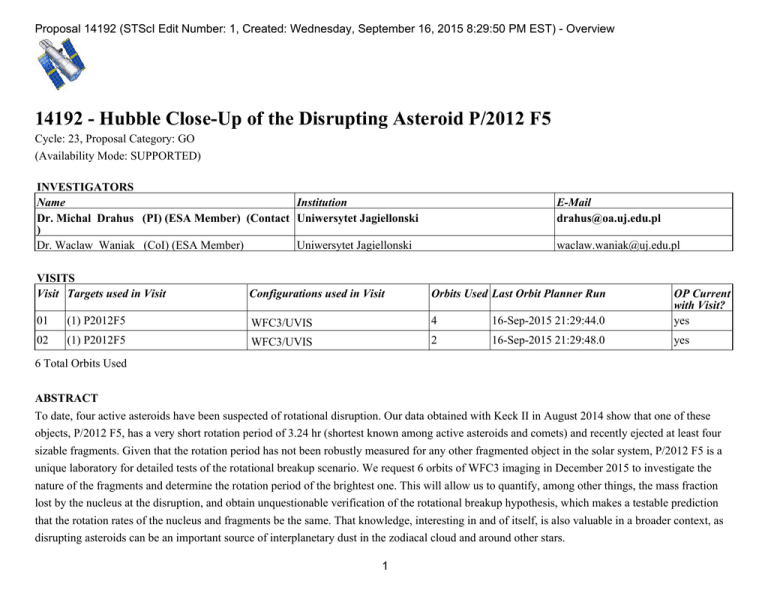
Proposal 14192 (STScI Edit Number: 1, Created: Wednesday, September 16, 2015 8:29:50 PM EST) - Overview 14192 - Hubble Close-Up of the Disrupting Asteroid P/2012 F5 Cycle: 23, Proposal Category: GO (Availability Mode: SUPPORTED) INVESTIGATORS Name Institution Dr. Michal Drahus (PI) (ESA Member) (Contact Uniwersytet Jagiellonski ) Dr. Waclaw Waniak (CoI) (ESA Member) Uniwersytet Jagiellonski E-Mail drahus@oa.uj.edu.pl waclaw.waniak@uj.edu.pl VISITS Visit Targets used in Visit Configurations used in Visit Orbits Used Last Orbit Planner Run 01 (1) P2012F5 WFC3/UVIS 4 16-Sep-2015 21:29:44.0 OP Current with Visit? yes 02 (1) P2012F5 WFC3/UVIS 2 16-Sep-2015 21:29:48.0 yes 6 Total Orbits Used ABSTRACT To date, four active asteroids have been suspected of rotational disruption. Our data obtained with Keck II in August 2014 show that one of these objects, P/2012 F5, has a very short rotation period of 3.24 hr (shortest known among active asteroids and comets) and recently ejected at least four sizable fragments. Given that the rotation period has not been robustly measured for any other fragmented object in the solar system, P/2012 F5 is a unique laboratory for detailed tests of the rotational breakup scenario. We request 6 orbits of WFC3 imaging in December 2015 to investigate the nature of the fragments and determine the rotation period of the brightest one. This will allow us to quantify, among other things, the mass fraction lost by the nucleus at the disruption, and obtain unquestionable verification of the rotational breakup hypothesis, which makes a testable prediction that the rotation rates of the nucleus and fragments be the same. That knowledge, interesting in and of itself, is also valuable in a broader context, as disrupting asteroids can be an important source of interplanetary dust in the zodiacal cloud and around other stars. 1 Proposal 14192 (STScI Edit Number: 1, Created: Wednesday, September 16, 2015 8:29:50 PM EST) - Overview OBSERVING DESCRIPTION I. TARGET, GOALS AND GENERAL APPROACH The target of these time-critical observations is a fragmented asteroid P/2012 F5, which has a bright nucleus and at least four fainter fragments embedded in a long dust trail. When in opposition, the nucleus is of 21.5 mag, the brightest fragment of 25.7 mag, and the three fainter fragments of about 26.5 mag (R-band magnitudes based on our Keck data from mid-2014). The TARGETS component contains the orbital elements of the main nucleus. The nucleus and the fragments are dispersed along a straight line. At the time of the expected HST observations (see below), the sky PA of this line is 269.5 deg, coinciding almost exactly with the E-W direction. The expected angular distance between the easternmost component (the main nucleus) and the westernmost component (one of the faint fragments) is 45 arcsec. However, the associated dust trail extends further out, and can be several arcminutes long. The orbit of our target is very well known, with a standard uncertainty of the target's position at the epoch of the expected observations at the level of 2 arcsec (obtained from the JPL Horizons system). Our program has two fundamental goals: (i) characterize the object's disruption and (ii) test the rotational disruption scenario. The first goal can be reached by obtaining a deep image of the object. The second goal requires a sequence of short exposures for time-series photometry. An obvious strategy is then to take short exposures with which to reach the second goal and then co-add them, generating a deep image with which to reach the first goal. II. VISITS AND SCHEDULING We request that data be taken in two visits separated by about 40 orbits (2 days 16 hr). The first visit requires 4 consecutive orbits, while the second visit requires 2 consecutive orbits. The rationale for the two visits is as follows. One HST orbit (96 min) takes nearly half the rotation period of our target (97.2 min). Because the target can only be observed for about half of the HST orbital period, data taken during the initial 4-orbit visit will sample only half of the object's rotation (strictly speaking, two quarters of the rotation cycle, each quarter observed twice, separated by two gaps of the same duration). In order to fill out the missing rotation phases, we need a second visit separated from the first visit by about 40 orbits (2 days 16 hr). During the second, 2-orbit visit we will observe the other half of the object's rotation that is behind the Earth's disk during the first visit (strictly speaking, we will observe the remaining two quarters of the rotation cycle, each quarter observed once). This will allow us to obtain a complete 2 Proposal 14192 (STScI Edit Number: 1, Created: Wednesday, September 16, 2015 8:29:50 PM EST) - Overview rotational light curve of the main nucleus and, more importantly, of the brightest fragment if both objects rotate at the same rate. The visit durations are in a 4:2 proportion so that the data collected during the first, longer visit can be also used to generate the deep, co-added image. Due to rapid changes in the object's viewing geometry, it will not be possible to co-add data from both visits, so it is better if one of the visits is longer than the other one. These observations are time-critical and should be executed when the first opportunity arises in mid-December 2015. At that time the target is in opposition, having a maximum brightness and a maximum SA close to 180 deg, and also the observing geometry matches that of our 2014 data, greatly simplifying data analysis. III. EXPOSURES Each orbit has basically the same architecture. We consistently use WFC3/UVIS with the F350LP filter, which offers the best SNR on asteroid nuclei. We wish to take six full-frame images per orbit, which is small enough to ensure parallel buffer dumps and good overall observing efficiency, but large enough to adequately sample the 194.4-min object's rotation. Orbital visibility allows us to take all six images with 368 sec integration time when a GS is re-acquired, or five images with 368 sec integration time and one image with 228 sec integration time when a new GS is acquired. We request that the ORIENT angle be close to 90 deg, implying that the U3 axis be close to the E-W direction. Given that our target is also oriented along the E-W direction in the requested observing window, the requested ORIENT angle ensures target orientation parallel to U3. Furthermore, we place the target's nucleus in the UVIS2-C1K1C-CTE aperture, resulting in all the fragments and dust being aligned along the WFC3's diagonal connecting quadrants C and B, which is also the instrument's tilt axis, minimizing geometric distortions. Conveniently, the nucleus and the known fragments will all be present in quadrant C, but thanks to full-frame readout, we will be able to detect new fragments at larger separations from the nucleus in quadrant B. To maximize observing efficiency dithering will be applied between consecutive orbits (i.e. all six exposures taken during a single orbit will not be dithered) through changing POS TARG offsets. Orbit to orbit dithering incurs no overheads, but naturally fills out the gap between the two UVIS detectors and mitigates the effect of bad pixels in a deep, visit-averaged image. To minimize the influence of geometric distortions, the POS TARG offsets "move" the target along the diagonal connecting quadrants C and B. 3 Proposal 14192 (STScI Edit Number: 1, Created: Wednesday, September 16, 2015 8:29:50 PM EST) - Overview IV. OUTCOME As the outcome of the observations we will obtain 36 exposures which will be measured photometrically. Assuming 368 sec integration time, the WFC3's ETC gives SNR > 100 for the main nucleus and SNR > 10 for the brightest fragment. These values demonstrate that the rotational light curve of the main nucleus will be trivial to measure, but also that we will be able to measure the rotational light curve of the brightest fragment and thereby obtain the highly anticipated measurement of its rotation period. Moreover, 24 exposures from the first visit will be co-added, resulting in a deep image with a limiting magnitude of 28.5 at SNR = 4. 4 Solar System Targets Visit Proposal 14192 - Visit 01 - Hubble Close-Up of the Disrupting Asteroid P/2012 F5 Proposal 14192, Visit 01, implementation Diagnostic Status: No Diagnostics Scientific Instruments: WFC3/UVIS Special Requirements: ORIENT 84D TO 96 D # Name Level 1 Level 2 (1) P2012F5 TYPE=ASTEROID,A=3.00352423824 508,E=0.04213406619531441,I=9.739 670284316066,O=216.8598007462,W =177.2949050283107,M=118.0382338 5515,EQUINOX=J2000,EPOCH=11DEC2011:00:00:00,EpochTimeScale=UTC Exposures # 1 Label Target (1) P2012F5 Config,Mode,Aperture WFC3/UVIS, ACCUM, UVIS2-C1K1C-CTE Spectral Els. F350LP 2 (1) P2012F5 WFC3/UVIS, ACCUM, UVIS2-C1K1C-CTE F350LP 3 (1) P2012F5 WFC3/UVIS, ACCUM, UVIS2-C1K1C-CTE F350LP 4 5 (1) P2012F5 (1) P2012F5 WFC3/UVIS, ACCUM, UVIS2-C1K1C-CTE WFC3/UVIS, ACCUM, UVIS2-C1K1C-CTE Thu Sep 17 01:29:50 GMT 2015 Level 3 Opt. Params. Window Special Reqs. Groups GS ACQ SCENARI O BASE1B3 POS TARG 1.25,1.2 5 F350LP POS TARG 2.50,2.5 0 F350LP POS TARG 3.75,3.7 5 5 Ephem Center EARTH Exp. Time (Total)/[Actual Dur.] 368 Secs X 5 (1840 Secs) [==>(Copy 1)] [==>(Copy 2)] [==>(Copy 3)] [==>(Copy 4)] [==>(Copy 5)] 228 Secs (228 Secs) [==>] 368 Secs X 6 (2208 Secs) [==>(Copy 1)] [==>(Copy 2)] [==>(Copy 3)] [==>(Copy 4)] [==>(Copy 5)] [==>(Copy 6)] 368 Secs X 6 (2208 Secs) [==>(Copy 1)] [==>(Copy 2)] [==>(Copy 3)] [==>(Copy 4)] [==>(Copy 5)] [==>(Copy 6)] 368 Secs X 6 (2208 Secs) [==>(Copy 1)] [==>(Copy 2)] [==>(Copy 3)] [==>(Copy 4)] [==>(Copy 5)] [==>(Copy 6)] Orbit [1] [1] [2] [3] [4] Orbit Structure Proposal 14192 - Visit 01 - Hubble Close-Up of the Disrupting Asteroid P/2012 F5 6 Proposal 14192 - Visit 01 - Hubble Close-Up of the Disrupting Asteroid P/2012 F5 7 Proposal 14192 - Visit 01 - Hubble Close-Up of the Disrupting Asteroid P/2012 F5 8 Proposal 14192 - Visit 01 - Hubble Close-Up of the Disrupting Asteroid P/2012 F5 9 Solar System Targets Visit Proposal 14192 - Visit 02 - Hubble Close-Up of the Disrupting Asteroid P/2012 F5 Proposal 14192, Visit 02, implementation Diagnostic Status: No Diagnostics Scientific Instruments: WFC3/UVIS Special Requirements: SAME ORIENT AS 01; AFTER 01 BY 2.6 D TO 2.7 D # Name Level 1 Level 2 (1) P2012F5 TYPE=ASTEROID,A=3.00352423824 508,E=0.04213406619531441,I=9.739 670284316066,O=216.8598007462,W =177.2949050283107,M=118.0382338 5515,EQUINOX=J2000,EPOCH=11DEC2011:00:00:00,EpochTimeScale=UTC Exposures # 1 Label Target (1) P2012F5 Config,Mode,Aperture WFC3/UVIS, ACCUM, UVIS2-C1K1C-CTE Spectral Els. F350LP 2 (1) P2012F5 WFC3/UVIS, ACCUM, UVIS2-C1K1C-CTE F350LP 3 (1) P2012F5 WFC3/UVIS, ACCUM, UVIS2-C1K1C-CTE F350LP Thu Sep 17 01:29:51 GMT 2015 Level 3 Opt. Params. Window Special Reqs. Groups GS ACQ SCENARI O BASE1B3 POS TARG 1.25,1.2 5 10 Ephem Center EARTH Exp. Time (Total)/[Actual Dur.] 368 Secs X 5 (1840 Secs) [==>(Copy 1)] [==>(Copy 2)] [==>(Copy 3)] [==>(Copy 4)] [==>(Copy 5)] 228 Secs (228 Secs) [==>] 368 Secs X 6 (2208 Secs) [==>(Copy 1)] [==>(Copy 2)] [==>(Copy 3)] [==>(Copy 4)] [==>(Copy 5)] [==>(Copy 6)] Orbit [1] [1] [2] Orbit Structure Proposal 14192 - Visit 02 - Hubble Close-Up of the Disrupting Asteroid P/2012 F5 11 Proposal 14192 - Visit 02 - Hubble Close-Up of the Disrupting Asteroid P/2012 F5 12
